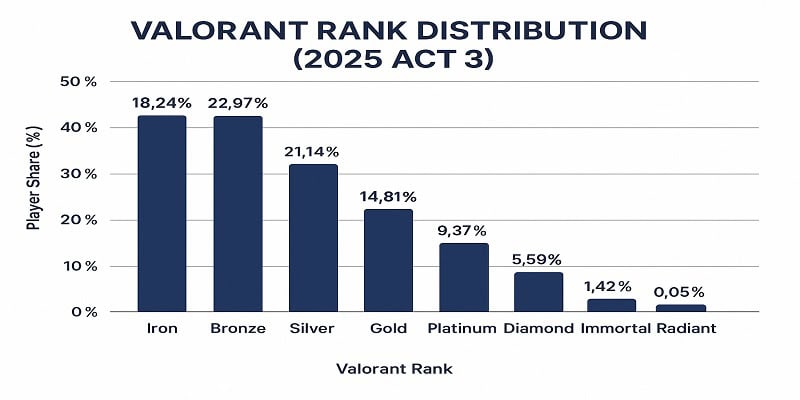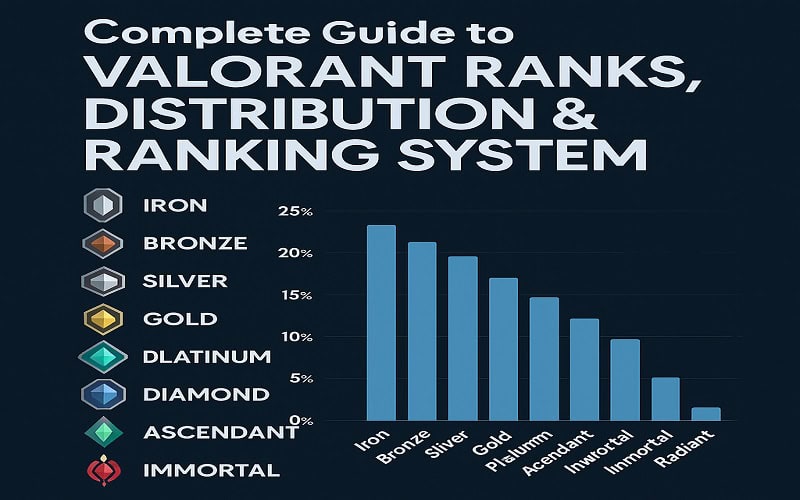Valorant, Riot Games’ tactical first-person shooter, has established itself as one of the most competitive online games in the world. At the heart of this competitive environment is its robust ranking system, which measures player skill, progression, and consistency. Whether you’re a newcomer aiming for your first placement or a seasoned veteran chasing Radiant, understanding how Valorant’s ranks work is key to your improvement and ranking journey.
What Are Valorant Ranks?
Valorant’s ranking system is a tiered structure designed to reflect a player’s skill level. There are 9 tiers, each with 3 divisions (except the top tier), resulting in 25 ranks in total:
- Iron 1 – Iron 3
- Bronze 1 – Bronze 3
- Silver 1 – Silver 3
- Gold 1 – Gold 3
- Platinum 1 – Platinum 3
- Diamond 1 – Diamond 3
- Ascendant 1 – Ascendant 3
- Immortal 1 – Immortal 3
- Radiant
Each rank is earned through Ranked Competitive matches, where players receive or lose Rank Rating (RR) based on performance, wins, and matchmaking balance.
How Does Valorant’s Ranking System Work?
Valorant’s rank progression is based on both individual performance and match outcomes. Here’s how it works:
- You start at 50 RR per tier.
- You need 100 RR to promote to the next tier.
- Performance (kills, plants, MVP status) impacts your RR gain or loss.
- Consistency and win streaks are rewarded with more RR.
- From Immortal upward, advancement depends on being in the top % of your region’s leaderboard.
Rank decay does not exist, but your hidden MMR (Matchmaking Rating) changes with inactivity or poor results, affecting future placements.
What Is an Act Rank?
Every Episode in Valorant contains multiple Acts. Your Act Rank represents your highest-ranked win during that Act and is displayed in a triangle badge. Regardless of how many games you play, your peak victory determines your Act Rank and the reward tier you receive.
Act Ranks reset with each new Act, but your previous MMR influences your next placement matches.
Valorant Rank Distribution (V25 Act 3)

Understanding rank distribution helps you gauge your skill against the broader player base. Based on data from vstats.gg, here’s how ranks are distributed:
| Rank | Player Share |
|---|---|
| Iron (1–3) | 6.40% |
| Bronze (1–3) | 18.24% |
| Silver (1–3) | 22.97% |
| Gold (1–3) | 21.14% |
| Platinum (1–3) | 14.81% |
| Diamond (1–3) | 9.37% |
| Ascendant (1–3) | 5.59% |
| Immortal (1–3) | 1.42% |
| Radiant | 0.05% |
This shows that most players reside in Silver and Gold, while only the top 1–2% make it into Immortal and Radiant.
Placement Matches & Requirements
To enter Competitive mode, players must:
- Reach Account Level 20
- Play 5 placement matches per Episode (only 1 match is needed for Acts 2 & 3)
Placement is based on both win rate and match performance. For example, consistently high-impact play may place you higher, even with 2–3 wins.
Ranked Grouping & Party Restrictions
Valorant allows players to queue in groups but has rank limitations to preserve match balance:
Solo or Duo Queue is allowed with similar skill tiers.
4-player parties are disabled to prevent solo queue abuse.
5-player parties are allowed without rank restrictions, but expect reduced RR gain if ranks vary too widely.
Group Rank Rules:
- Lowest rank Iron/Bronze → highest can be Silver
- Lowest rank Silver → highest can be Gold
- Lowest rank Gold → highest can be Platinum
- Lowest rank Platinum+ → 1-tier difference max
Tips to Rank Up Faster
Master Mechanics: Improve your aim, recoil control, and crosshair placement in the Practice Range.
Play Agents Smartly: Understand agent roles (Duelist, Initiator, Controller, Sentinel) and focus on mastering 1–2 per category.
Practice Communication: Use clear and constructive voice comms to improve coordination.
Review and Adapt: Watch replays, learn from mistakes, and adjust tactics based on the opponent’s playstyle.
Stay Positive: A winning mentality helps you maintain consistency and avoid tilt-related losses.
Conclusion: What Valorant Rank Means for You
Climbing the ranks in Valorant is both a testament to your mechanical skill and your ability to work with a team. The structured ranking system, combined with clear metrics and performance-based progression, makes it an ideal environment for both casual and competitive players.
Whether you’re in Iron learning the ropes or aiming for Radiant, every match is a step forward. Valorant’s system ensures that improvement leads to reward. So gear up, practice hard, and take your place in the competitive ladder.
Conclusion: Mastering the Valorant Ranking System
Valorant’s ranking system is not just a measure of skill, but a roadmap for personal growth and competitive excellence. From Iron to Radiant, each tier represents thousands of hours of practice, communication, and game sense. Whether you’re a casual gamer looking to improve or an aspiring pro climbing the ladder, understanding how Valorant ranks, MMR, Act Rank, and RR work will give you a significant edge.
Stay consistent, focus on team play, and track your improvement rather than obsessing over fast rank gains. With the right mindset and dedication, you’ll eventually reach the tier that truly reflects your potential.
Frequently Asked Questions (FAQs)
1. How do I unlock Competitive mode in Valorant?
To access Ranked matches, you need to reach Account Level 20. This ensures players have enough experience with game mechanics before entering competitive play.
2. How many placement matches do I need to play?
At the start of each Episode, you must play 5 placement matches. For Acts 2 and 3 within the same Episode, only 1 match is required to determine your rank.
3. Do ranks reset in Valorant?
Yes, ranks reset at the beginning of each Act. However, your MMR (Matchmaking Rating) carries over and influences your next placement.
4. What’s the difference between Rank and MMR?
Rank is your visible tier (e.g., Gold 2).
MMR is your hidden skill rating used for matchmaking.
You may gain or lose RR depending on your MMR vs. your current rank.
5. How can I rank up faster in Valorant?
Win games consistently
Perform well (kills, plants, MVPs)
Practice aim and game sense
Communicate effectively with your team
Consistency and improvement matter more than just kill counts.
6. Can I play with friends of different ranks?
Yes, but with limitations:
2–3 player groups must be within specific rank ranges.
5-player parties can have any rank mix but may get reduced RR gains if ranks vary too much.
7. Does inactivity affect my rank?
No, you won’t lose your visible rank due to inactivity. However, your MMR may decay, affecting your future match placements and performance.
8. What is the highest rank in Valorant?
Radiant is the highest and most exclusive rank, limited to the top 500 players per region.


